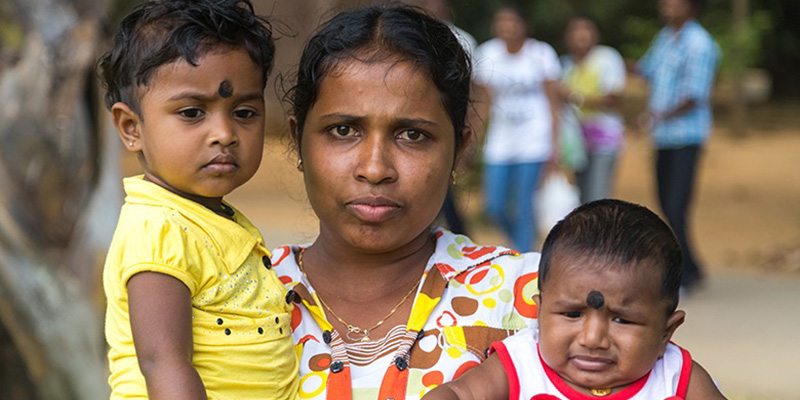The decision to withdraw the Cabinet Ministry of Women and Child Affairs after the recent Parliamentary elections aroused public outrage following a Gazette notification that detailed the relegation of ‘Women and Child Development,’ among other significant mandates, to the Ministry of Education. This decision carries two key problems. Not only has the Women and Child Affairs Ministry been demoted to that of a State Ministry, tossed in with several other mandates, but it is also presently headed by a male figure, politician Piyal Nishantha De Silva, who has been appointed as the State Minister of Women and Child Development, Pre-School and Primary Education, School Infrastructure and School Services.
While previous Cabinet portfolios have also been less than ideal, the present Cabinet continues to disappoint, due to the misaligned and fragmented nature of the cabinet ministries. The State Ministry headed by Hon. Piyal Nishantha covers a range of amalgamated mandates from Women and Child Development, Pre-School and Primary Education to School Infrastructure and School Services. The failure to assign a separate Ministry for women’s affairs strongly implies that the priority of empowering women and girls in Sri Lanka and advancing their rights have been put in the back burner. What is more, Hon. Piyal Nishantha, the State Minister of the said mandate, ranks 186th of 236 Parliamentarians and holds a 57% Parliamentary attendance rate, with his most discussed topics being education, trade and industry, according to Manthri.lk.
A separate Ministry for Women’s Affairs is vital in empowering and advancing the rights and freedom of women and girls in Sri Lanka. Women constitute almost 52% of Sri Lanka’s total population. Yet, not only are their voices inadequately represented in the political arena, with only twelve women MPs in the present Parliament, but the absence of a separate Ministry to handle the many issues women face is yet another hurdle in Sri Lanka’s long and grueling road towards gender equality.
Separate mandate = holistic impact
Needless to say, the scope of women and child affairs is unquestionably broad and multi-dimensional. Therefore, allocating a separate Cabinet ministry for this significant purpose seemed like a foregone conclusion, until now. In an appeal to establish a separate Cabinet Ministry for Women and Child Affairs, distinguished academics and activists wrote a letter to President Gotabhaya Rajapaksa, asserting that it “suggests that the government considers the important area of women’s and children’s affairs, an area of narrow interest, that require minimum resources and limited interventions.” The letter goes on to state that national development and progress would not be complete unless the government addresses the wellbeing of Sri Lanka’s women and children who make up for 13 million (51%) and 6 million (25%) of the total population, respectively. The signatories also did well to remind the Government that Sri Lanka is a State Party to both The Convention on the Elimination of All Forms of Discrimination against Women 1981 (CEDAW) and United Nations Convention of Children 1991 (UNCRC) which entails an obligation to ensure the effective protection of women against discrimination and protect and fulfill the rights of children.
Sri Lanka’s commitment to achieving the Sustainable Development Goals (SDGs), particularly Goal 5 – “achieve gender equality and empower all women and girls,” is noteworthy. Such a commitment requires the effective mainstreaming of gender-sensitive policies across all sectors. The letter also emphasized the government’s role in moving closer to achieving these SDGs through effective decisions made “at the highest levels of government.” Thereby, relegating women’s and child’s affairs to the Ministry of Education is neither logical nor a feasible approach to attaining this goal.

Disturbing levels of gender-based violence, from domestic abuse, intimate partner violence, forced early marriage to marital rape and other forms of gendered violence directed at women and girls are sadly pervasive in Sri Lanka. Women and girls continue to be discriminated based on their gender – from educational opportunities, treatment at the workplace, prospects for leadership and biases in Sri Lanka’s political arena.
What is more, Sajini Wickramasinghe, the President of Law Students’ Association of Sri Lanka and the Founder of Democracy and Governance Initiative of Sri Lanka told Pulse that with this decision, it becomes easier for the State Ministry to evade responsibility because several different mandates fall under its purview. “When there’s a Cabinet ministry for women’s affairs, that minister is solely responsible for any piece of legislation or action detrimental to women. Anyone can directly pose their questions, requests and suggestions,” stated Sajini, who also pointed out that while the Cabinet is part of the Executive branch of Sri Lanka, State Ministers are not.
“Therefore if there was a Cabinet Ministry for women, the relevant minister can directly influence cabinet decision-making, provide input or raise objections if it concerns women.” Sajini is presently working on a petition regarding the matter. Commenting on this venture, she states that “as activists who have worked with ground-level women, we have a responsibility to educate the Minister and rest of Parliament about the realities that women face daily. That is why I initiated a petition which includes all aspects of women’s issues, from violence to discriminatory legislation, including what has to change.” With the support of other women’s rights activists, she hopes to present the trilingual document to relevant parties by October this year. She also poses a pertinent question regarding the government’s approach to women’s affairs. “When the Government still looks at a woman from welfare-based “motherly-figure” ideals, how can we expect any promotion of women’s rights and freedom in the country?” she asserts, while making a plea for the state to adopt a “rights-based approach.”
Besides, longstanding calls by various stakeholders to push for MMDA (Muslim Marriage and Divorce Act) reform – an archaic law that does not specify a minimum age for Muslim marriage, among other concerns – and shocking spikes in child sexual abuse cases, for example, are just a fraction of the innumerable concerns that threaten the rights of women and children. In the same vein, such issues require top levels of government to effectively implement laws, policies and necessary reforms to ensure that the rights and freedoms of women are safeguarded.
Successes of previous Cabinet Ministries on Women’s Affairs
A Women’s Bureau was first established under the tenure of President J. R Jayawardene in 1978, under the Ministry of Plan Implementation. Subsequently, the Ministry of Women’s Affairs was created in 1997 and continued to function as a separate Cabinet Ministry with minor changes to its mandate, including the addition of Social Welfare in 2004 and Child Development in 2006, in successive regimes.
The Ministry of Women and Child Affairs (MWCA), belonging to the previous Cabinet portfolio, was set up under Gazette Extraordinary No. 1933 of 9th September 2015.
Major responsibilities according to the Gazette included the formulation of policies, programmes and projects, monitoring and evaluation concerning women and children, enhancement of women’s participation and their representation in decision-making in public affairs and politics, empowerment of women-headed households and women affected by conflict and poverty as well as implementing and strengthening laws and policies for the prevention of women and child abuse.
The National Committee on Women was the culmination of the previous Ministries’ promulgation of the historic Women’s Charter which was approved on March 3rd, 1993. The Charter set forth the political, civil, educational, and economic rights of women, protection from discrimination and gender-based violence and capped the minimum age of employment at 15 years.
Further, the Ministry of Child Development and Women’s Empowerment under the 2006 regime, successfully enacted the Prevention of Domestic Violence Act No.34 of 2005. Thereby, Sri Lanka became only four of eight countries in South Asia that officially have laws specifically prohibiting domestic violence. Additionally, as an immediate relief for survivors of domestic violence, the MWCA entered into a Memorandum of Understanding with Women in Need (WIN) and Jaffna Social Action Centre to assist in administering protection shelters to women who have faced violence.
The creation of the 1938 helpline established in March 2016 by the MWCA was another major step in providing direct assistance and relief to women facing discrimination and violence. The Ministry had also taken steps to conduct Gender Mainstreaming programmes for school textbook writers and was making headway in reviewing school textbooks to integrate gender-sensitive content in collaboration with the Ministry of Education. With regard to the welfare of female prisoners, the National Committee on Women initiated discussions with prison management to take action in addressing the grievances of female prisoners. Such initiatives are a few examples, among several others, that suggest the need for a separate Cabinet Ministry for Women’s Affairs.
Male leadership and female underrepresentation
In a country that has a long way to go in achieving gender equality, the fact that women are best able to represent and meaningfully work towards issues that address their wellbeing has been commonly accepted. In fact, several studies on women’s representation show that female MPs represent issues concerning women more strongly and more credibly, especially in the legislative sphere than their male colleagues, because they share their social identity and gender-specific experiences. In this vein, the appointment of a male politician to head the State Ministry on ‘women and child development’ has certainly raised eyebrows and aroused public concern. This issue adds on to other concerning patterns of persistent levels of low women’s representation in political and electoral processes – with only 12 women in Sri Lanka’s present Parliament.
With growing consensus on the need for more women’s leadership in top levels of government and public affairs, an article by Forbes points out “once women land leadership positions they excel – often surpassing men – because they have developed soft skills necessary for effective leadership.” Skills such as communication, listening and empathy are exhibited by women more than men, who are also often shown to use collaboration and attention to detail as best courses of action. Women are proven to be more sensitive to policies, legal reform and initiatives relating to maternal leave, elderly care, flexible working hours, childcare and other areas that promote inclusive and equitable societies.
Women’s representation in Sri Lanka’s Parliament, provincial and local bodies continues to be severely unrepresented. Gender stereotypes, family disapproval, financial barriers and the absence of a welcoming environment that facilitates active and meaningful participation of women in political spheres are some of several reasons behind this disappointing reality.
The onus falls on the Government of Sri Lanka to actively work towards creating and implementing progressive laws that include and value the work of women in the political arena. At a time when the Ministry of Women and Child Affairs was making great strides in advancing the rights of women and girls in Sri Lanka, collective efforts need to be made to ensure that we are not, in fact, moving backward.
The post Pulse Reflects: The Absence of a Cabinet Ministry for Women’s Affairs appeared first on Pulse.
Source From Pulse.lk
Author: Renushi Ubeyratne
#SriLanka #News #lka

